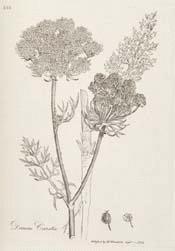
Botanical.com Home Page

|
Carrot
(Daucus carota)
Click on graphic for larger image
|
Carrot, Wild
Botanical: Daucus carota (LINN.)
Family: N.O. Umbelliferae
---Synonyms---Birds' Nest and Bees' Nest.
---Parts Used---Whole herb, seeds, root.
---Habitat---Britain, near the sea in greatest abundance, and in waste places throughout Europe, Russian Asia, America, and is even found in India.
---Habitat---Probably originally a native of the sea-coasts of Southern Europe degenerated into its present wild state, but of very ancient cultivation. The name 'Carrot' is Celtic, and means 'red of colour,' and Daucus from the Greek dais to burn, signifying its pungent and stimulating qualities.
The Carrot was in ancient times much valued for its medicinal properties; the Wild Carrot, which is found so plentifully in Britain, both in cultivated lands and by waysides, thriving more especially by the sea, is superior, medicinally, to the cultivated kind.
---Description---Its root is small and spindle shaped, whitish, slender and hard, witha strong aromatic smell and an acrid, disagreeable taste, very different to the reddish, thick, fleshy, cultivated form, with its pleasant odour and peculiar, sweet, mucilaginous flavour. It penetrates some distance into the ground, having only a few lateral rootlets.
The stems are erect and branched, generally about 2 feet high, tough and furrowed. Both stems and leaves are more or less clothed with stout coarse hairs. The leaves are very finely divided, the lowest leaves considerably larger than the upper; their arrangement on the stem is alternate, and all the leaves embrace the stem with the sheathing base, which is so characteristic of this group of plants, the Umbelliferae, to which the Carrot belongs. The blossoms are densely clustered together in terminal umbels, or flattened heads, in which the flower-bearing stalks of the head all arise from one point in rays, like the ribs of an umbrella, each ray again dividing in the case of the Carrot, in like manner to form a secondary umbel, or umbellule of white flowers, the outer ones of which are irregular and larger than the others. The Wild Carrot is in bloom from June to August, but often continues flowering much longer. The flowers themselves are very small, but from their whiteness and number, they form a conspicuous head nearly flat while in bloom, or slightly convex, but as the seeds ripen, the umbels contract, the outer rays, which are to begin with 1 to 2 inches long, lengthening and curving inwards, so that the head forms a hollow cup hence one of the old popular names for the plant - Birds' Nest. The fruit is slightly flattened, with numerous bristles arranged in five rows. The ring of finely-divided and leaf-like bracts at the point where the umbel springs is a noticeable feature.
The Carrot is well distinguished from other plants of the same order by having the central flower of the umbel, or sometimes a tiny umbellule, of a bright red or deep purple colour, though there is a variety, Daucus maritimus, frequent in many parts of the seacoast in the south of England, which differs in having somewhat fleshy leaves and no central purple flower. In this case, all the flowers of the head have usually a somewhat pinkish tinge. There was a curious superstition that this small purple flower of the Carrot was of benefit for mitigating epilepsy.
[Top]
---Constituents---The medicinal properties of the seeds are owing to a volatile oil which is colourless or slightly tinged with yellow; this is procured by distilling with water. They also yield their virtues by infusion to water at 212 degrees F.; boiling dissipates them. No thorough analysis has been made.
---Medicinal Action and Uses---Diuretic, stimulant deobstruent. An infusion of the whole herb is considered an active and valuable remedy in the treatment of dropsy, chronic kidney diseases and affections of the bladder. The infusion, made from 1 OZ. of the herb in a pint of boiling water, is taken in wineglassful doses. Carrot tea, taken night and morning, and brewed in this manner from the whole front, is considered excellent for a gouty disposition. A strong decoction is very useful in gravel and stone, and is good against flatulence. A fluid extract is also prepared, the dose being from 1/2 to 1 drachm.
The seeds are carminative, stimulant and very useful in flatulence, windy colic, hiccough, dysentery, chronic coughs, etc. The dose of the seeds, bruised, is from one-third to one teaspoonful, repeated as necessary. They were at one time considered a valuable remedy for calculus complaints. They are excellent in obstructions of the viscera, in jaundice (for which they were formerly considered a specific), and in the beginnings of dropsies, and are also of service as an emmenagogue. They have a slight aromatic smell and a warm, pungent taste. They communicate an agreeable flavour to malt liquor, if infused in it while working in the vat, and render it a useful drink in scorbutic disorders.
Old writers tell us that a poultice made of the roots has been found to mitigate the pain of cancerous ulcers, and that the leaves, applied with honey, cleanse running sores and ulcers. An infusion of the root was also used as an aperient.
[Top]
Common Name Index
A MODERN HERBAL Home Page
Bear in mind "A Modern Herbal" was written with the conventional wisdom of the early 1900's. This should be taken into account as some of the information may now be considered inaccurate, or not in accordance with modern medicine.
© Copyright Protected 1995-2025 Botanical.com
|

